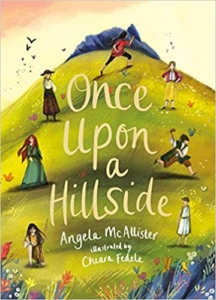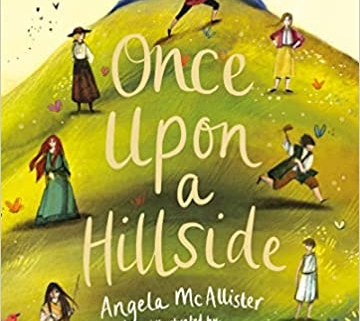Once Upon a Hillside by Angela McAllister
Once Upon a Hillside is a collection of stories woven across the fabric of the land. Written by Angela McAllister, we have a brilliant blog post about where these stories came from.

A few years ago, Fiona Kennedy, a publisher and editor I’ve worked with on many books over the years, came to visit me at my old cottage on the edge of the downs. We took a long walk together across the chalk land, sharing our love of landscape, history and folklore. I showed her prehistoric barrows and ditches, places charged with traces of the ancestors, and back home by the fire put their flint axes and arrowheads into her hands.
Several months later, having endured lockdown, Fiona rang and asked me to write a book set on the down; a book about its wildlife and history but, above all, about the healing power of nature which we had all come to value so much during the pandemic. It was an amazing gift – an opportunity to immerse myself in the landscape that, over thirty years, had grown into my bones, to spend time listening for its stories and to share its wonders.
It was also a timely commission, as school closures and the restrictions of lockdown had encouraged families to explore their local wild places, developing curiosity about the natural world around them. Here was a chance to show what can be discovered by looking more closely at your surroundings, asking questions about what you find and thinking about who might have been there before you.
The task of finding seven stories seemed daunting at first – Martin Down nature reserve, where the book is set, is open land grazed by sheep, scattered with thorn bushes and scrub, edged with woodland and arable fields. It seems an unlikely place to find a story. But, as the character Clare Sweetapple discovers, everything is more than it seems there.
I already had many prompts – fossils nestled on the shelves of my study, flint artefacts, albums of wildflower photographs, fragments of pottery picked out of molehills, wildlife notes from walks with the warden and archaeological records I’d pored over many times. All of these were waiting to tell their stories. Several themes suggested themselves too. The first story, White Bird, involves a spiritual interaction with the natural world, The Hare in the Moon touches on mythology, Wildmaid is written around wildflowers and herbal remedies, Lost and Found is set in the world of sheep and shepherding, The Time Travelling Stone has an archaeological setting, Lost and Found focusses on the animals of the downland and the final story, Granny Down, encompasses all of these – and it was here that I met myself and realised that this book was to be my own story.
Luckily, these themes fell into place within a time-frame that created the structure of the bookand it began to shape up. At this point, knowing me well, Fiona gently pointed out the danger of too much waxing lyrical about orchids and skylarks and the pitfall of getting lost in research. What was needed were stories.
Unexpectedly, in order to find the stories I had to stop walking on the down. To give space and time for characters to arrive it was necessary to keep away and watch from a distance. My down had to be their down, an environment they were free to explore and inhabit, I couldn’t risk meeting them along the path. Happily, the characters soon appeared and began interacting with the landscape and slowly it was transformed into a story world – like a familiar place encountered in a dream. The stories crafted it to their purpose, subtly changing the landscape, moving a juniper tree from here to there, turning a round barrow into a long barrow, planting an ash tree at the field gate. It created its own topography, a new land of the imagination.
During the months of writing that followed, I experienced the down more vividly than ever before, walking its story paths each day, drawing on every sensation it offered, and yet at the same time I was missing it dreadfully and longed to be there. It made me realise how deeply it had become my heart’s home.
Once the stories were written I thought the spell would be broken, but to my delight I was wrong. When I stepped out along the flinty track once more the characters who’d arrived in my absence were still there. I saw Tani gazing across the valley from the hilltop, Corio standing on the barrow, scanning the roman road, Ailith sweeping her fingertips through the long grasses, Liddy among the ewes, Clara studying insects on the wildflowers, Peggy lying in the sun, staring up at the skylarks and my own shadow, where Granny Down herself had walked. Like a seam of flint in the chalk, the stories are now embedded in that place.
Next spring, I hope to be taking readers on a story walk across the down, maybe we’ll take a picnic, like Peggy, Dennis and little Stanley. With luck, we’ll meet the children of ‘Once Upon a Hillside’ along our way.
Once Upon a Hillside is published by Zephyr Books and is available now.
Views expressed do not necessarily reflect those of the Federation.




